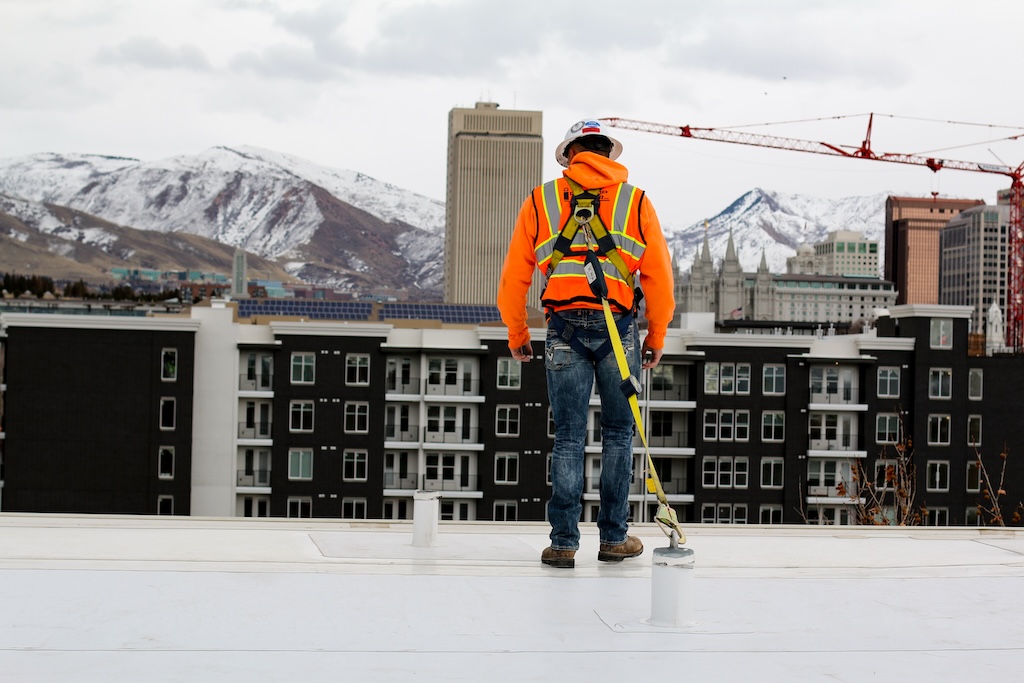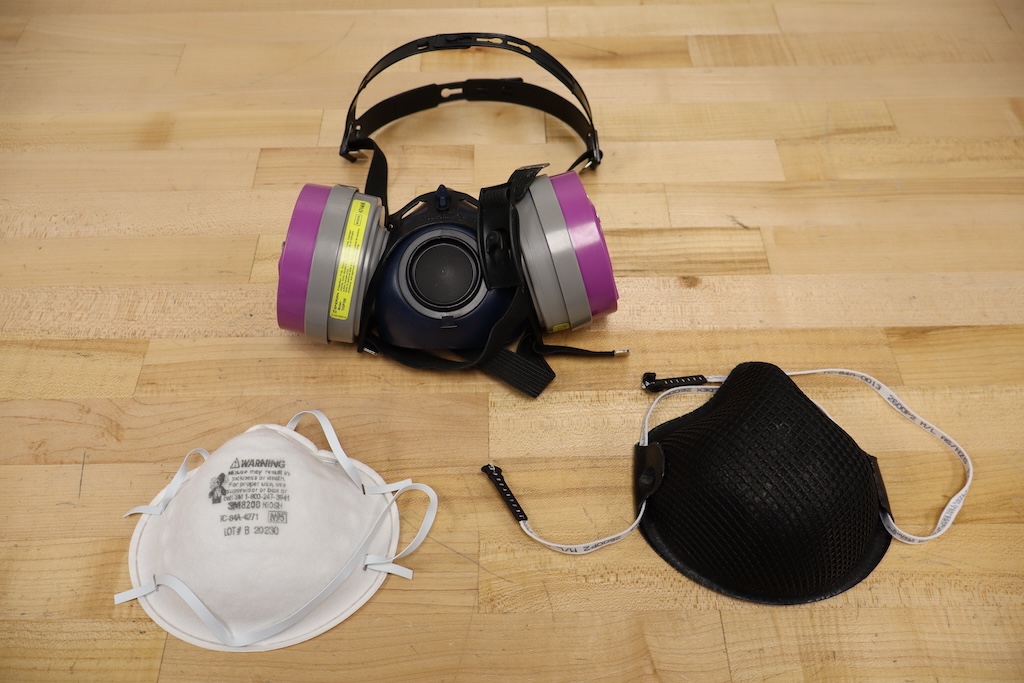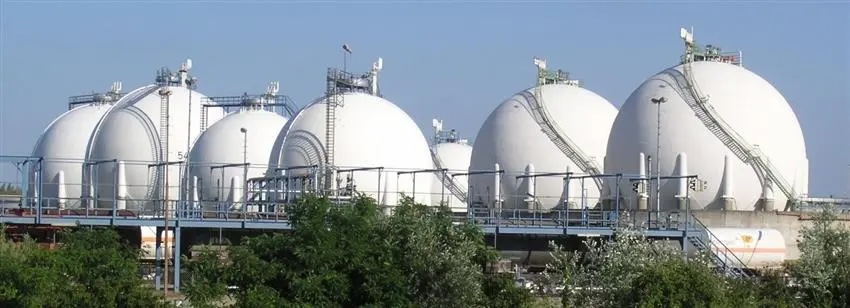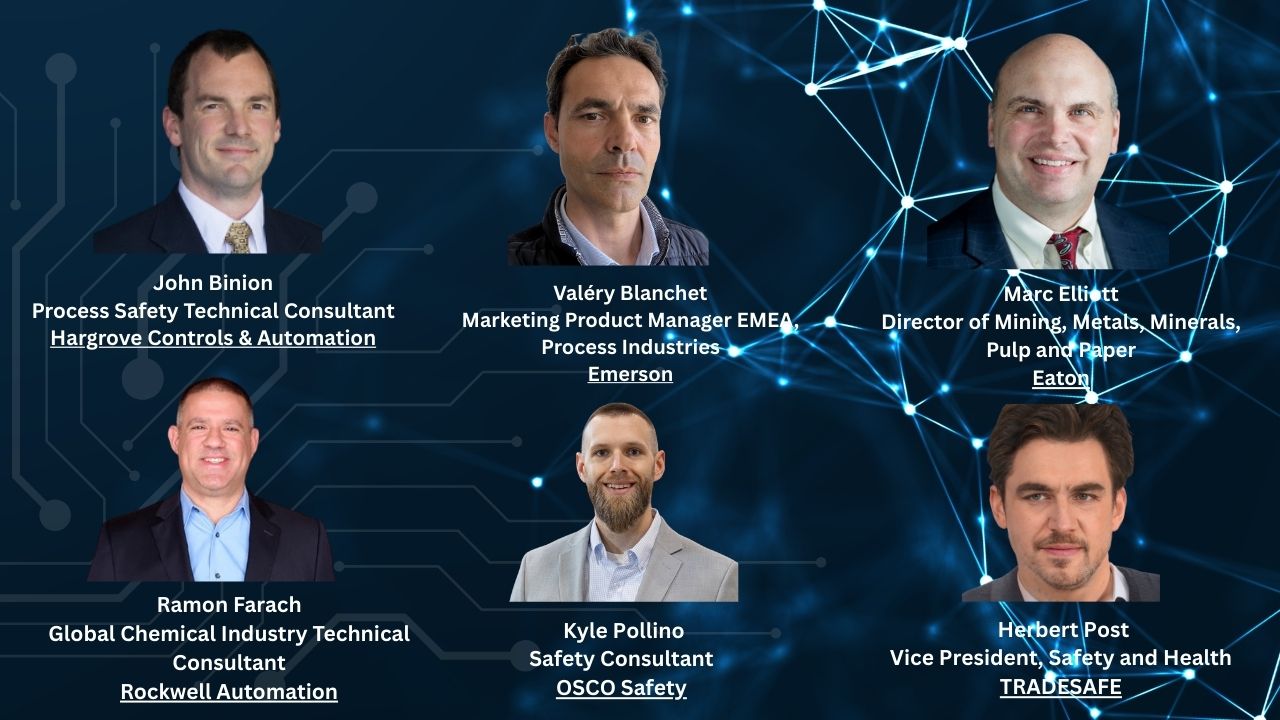
Safety hazards insights
- Getting ahead of hazards through predictive and preventive maintenance is a current trend.
- It’s imperative for organizations to continue training in hazard prevention –– even after they’ve adopted a plan.
- Technology, including software, augmented reality and virtual reality, are changing the ways in which workers engage in safety training.
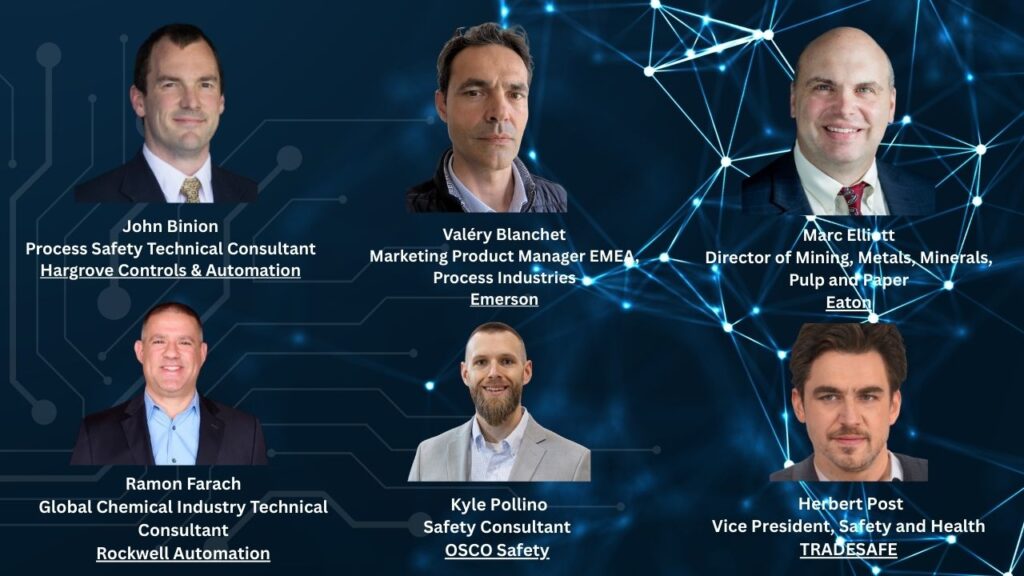
What are some of the current hazard protection trends for industrial and manufacturing facilities?
Kyle Pollino: Current hazard protection trends for industrial and manufacturing facilities are increased awareness of fall protection, heightened awareness of rooftop safety and the use of crossover systems for greater safety around machinery and robotics.
Valéry Blanchet: Current trends in hazard protection for industrial and manufacturing facilities include proactive risk management and safety monitoring. Additionally, there’s a focus on predictive maintenance tools to ensure the best level of protection anytime.
Herbert Post: Everyone’s obsessed with predictive analytics now. I’ve heard of facilities installing internet of things (IoT) sensors everywhere with temperature monitors, vibration detectors, ergonomic sensors and gas sensors all feeding data to AI systems that supposedly predict failures before they happen.
Is it perfect? Nope. But it beats waiting for something to break.
Another trend that’s impossible to ignore is wearable tech. Hard hats with built-in sensors, smart safety vests that track worker locations. I’ve even seen computer-generated and physical exoskeletons being tested to reduce strain injuries. But getting workers to wear all this stuff remains a challenge, especially workers who feel like they’re being watched constantly.
There’s also been a massive push toward inherently safer design. Basically, instead of adding more safety equipment, facilities are redesigning processes to eliminate hazards entirely, like switching to less toxic chemicals or lowering operating pressures. It makes sense when you think about it, as this uses the process of elimination and engineering to control hazards rather than depend on administrative controls or personal protective equipment (PPE).
Marc Elliott: At Eaton, we’re seeing hazard protection trends increasingly centered around proactive, data-driven maintenance practices and workforce training.
One major shift was the 2023 update to NFPA 70B: Standard for Electrical Equipment Maintenance, which now requires facilities to implement an electrical maintenance program (EMP). This standard necessitates the ongoing evaluation of equipment condition to determine appropriate maintenance intervals. As with any EMP, the goal should be to establish an electrically safe working condition. That task can be simplified by using the operational data insights provided by digital technologies such as advanced sensors and software platforms that allow organizations to make smarter maintenance decisions based on continuous monitoring, refined data analytics and real-time diagnostics. These digital solutions can both simplify and improve traditional maintenance by providing the insights needed to properly maintain electrical equipment without personnel needing to physically occupy energized, hazardous environments.
Equally important is identifying the resources needed to help equip employees with the vast knowledge needed to maintain modern electrical systems. When it comes to electrical safety education, there are more flexible options than ever before. For example, Eaton offers a comprehensive range of learning formats –– including in-person, remote and on-demand –– that help organizations build a skilled workforce capable of sustaining a culture of safety throughout the equipment life cycle. We even offer in-person training directly at our customer’s sites so personnel can learn hands on in their own environment, with proper safety procedures implemented.
Ramon Farach: Rockwell Automation collaborates with many customers to design, implement and maintain safety instrumented systems (SIS). Historically, customers wanted to have dissimilar hardware and software for their SIS and their basic process control system (BPCS). This helped prevent an engineer or technician from accidentally working on the SIS when they meant to change the distributed control system (DCS). But it also requires extra training and staff who can work on both systems. Customers have taken an interest in keeping the BPCS and the DCS on the same hardware and software platform for ease of training, maintenance and use of common spares. They’re relying more on software-based safeguards like safety signatures and software locks to prevent mistakenly changing the wrong system.
Looking ahead one to two years, what future trends should engineers, plant managers and designers expect for hazard protection?
John Binion: As one would expect, standards are getting stricter and less leniency is being granted when it comes to safety and environmental impacts that arise due to hazardous areas. As a process hazard analysis (PHA) facilitator, I am seeing more sites address hazards as if they are a given.
Marc Elliott: Looking ahead, engineers, plant managers and designers should prepare for a continued evolution of hazard protection best practices driven by the megatrends of electrification, decarbonization and increasing digitalization. As electrical systems grow in complexity, the evolution of EMPs must be seen as an ongoing journey.
For example, a key trend shaping the future of industrial environments is the rapid transformation of electrical systems. As facilities integrate renewable energy sources, electric vehicle (EV) fleet charging and the electrification of currently nonelectrical processes to support broader decarbonization efforts, the associated electrical loads and system configurations become much more complex. This introduces safety challenges and requires a new, deeper understanding of how to properly interact with and maintain these systems. It’s not just about understanding how these new components work, but about ensuring workers are trained to safely interact with them and that protection systems are designed and sized correctly to safely manage evolving energy demands.
Regulatory changes are also on the horizon. Committees for NFPA 70: National Electrical Code and NFPA 70B are preparing updates for the 2026 code cycle with expected changes reflecting current industrial electrical system trends. These include expanded guidance on higher voltage systems, updated arc flash labeling requirements, accommodations for EV charging infrastructure and refined working space standards. For NFPA 70B specifically, revised language is anticipated that reinforces the use of digital monitoring solutions to determine maintenance intervals, further reinforcing the shift toward predictive, condition-based strategies.
Even if the latest codes aren’t immediately adopted in every jurisdiction, it’s vital to recognize that relying on outdated standards can result in missed opportunities for safety improvements and modern best practices. By staying ahead of upcoming changes and designing with the latest standards in mind, facilities can elevate their safety posture well beyond the baseline, enhancing both personnel protection and operational reliability.
Herbert Post: The big standard coming could include the Occupational Safety and Health Administration’s (OSHA) heat illness prevention standard.
There are a lot of practical ways to monitor worker safety, as we are already seeing facilities install cooling stations, but the acclimatization tracking is tricky. How do you document someone’s heat exposure over two weeks?
Some facilities run contests or standardize the workers’ water consumption, whereby they track the amount of water/hydration product they drink, which helps workers become more aware of their own hydration. There are also products that base their hydration formulas on scientific studies involving sweat and salt consumption. Hazard control also includes work/rest regimens for specific PPE. Tools like the heat index and the wet-bulb globe temperature are still widely used to manage heat exposure and reduce injuries.
Artificial intelligence (AI) predictive maintenance is finally becoming practical. Insurance companies are starting to offer discounts for facilities using IoT sensors. System costs depend on monitoring. A basic vibration setup for critical pumps can be cheaper than full plant coverage. Most vendors claim to see a 12- to 18-month payback through prevented failures.
Wearables also keep getting pushed by vendors. These show significant reductions in overexposure incidents by tracking cumulative exposure to hazards like silica, noise and chemical vapors. These devices are getting more sophisticated. Some now sync with facility management systems to create heat maps of exposure zones.
Connected worker platforms are also interesting. Real-time location tracking, man-down alerts and emergency mustering turn workers into walking data points. Privacy concerns aside, these are becoming standard for remote, confined-space monitoring and high-risk areas. Some integrate with access control wherein gates won’t open if you don’t have the right training certificate on file.
Kyle Pollino: Looking ahead one to two years, the future trends managers should expect in hazard protection are tools to safeguard workers from rapidly evolving technology, such as automated equipment and robotics.
These technological advances can improve performance and throughput, but safety measures such as lane control and protective guarding will be important as humans and machines learn to work together in the industrial world.
Ramon Farach: The use of AI will become more prevalent in plants, first around process optimization and asset management, but it will extend to advanced detection of process hazards and alerting operators to take corrective action sooner. This requires a robust, modern operational technology (OT) foundation that can be connected to the information technology (IT) system required to analyze data and provide operator feedback. However, most chemical manufacturers are just starting to consider modernization and digitalization of their plants. It’s time for facilities to assess automation and control systems and begin their modernization and digitalization journey.
Describe a project in which you had to design or modify systems to protect from a hazardous environment. What were the challenges and solutions?
Valéry Blanchet: A rubber manufacturer needed to replace a 40-year-old tank system. Emerson delivered an industry compliant solution with higher peak pressure capability and advanced piloting and monitoring controls to ensure longer service life, lower emissions and streamlined operation.
It is a typical example where efficiency, productivity and safety has been improved with a better control and technical improvements.
Kyle Pollino: A recent project involved a client that needed access to two elevated tanks to perform routine maintenance on the tanks. The challenges included working around preexisting structures and addressing areas of heavy pedestrian traffic. We were able to install the ReadySeries modular stair tower system, which shipped fully assembled for the least amount of downtime. We also provided a full Professional Engineer-stamped engineering package to ensure the structural integrity of the system.
What types of computer applications are in use to support your hazard protection functions?
Marc Elliott: Modern industrial facilities are increasingly turning to digital technologies and analytics platforms to enhance safety, particularly when working on or near energized electrical equipment.
A foundational safety principle is hazard elimination, which is the practice of establishing an electrically safe working condition by de-energizing equipment, following lockout/tagout procedures and verifying the absence of voltage. Traditionally, this verification relied on manually operated portable testers and proper PPE. However, these processes depend on flawless human execution, which introduces risk. Smart sensors –– found in electric devices such as power meters and relays, motor starter overloads, circuit breaker trip units and industrial lighting fixtures –– and software solutions can digitally confirm the presence of power, reducing the need for direct human contact and enabling safer decision making.
Smart equipment-level sensors now provide real-time data on power status, load levels and power quality – empowering personnel to assess equipment conditions without opening enclosures or physically interacting with live systems. These systems can generate trend reports that identify anomalies before they develop into dangerous faults. In scenarios where full de-energization isn’t feasible, digital indicators can alert workers to which parts of the system remain energized and which are safe, aiding in PPE selection and reducing the likelihood of arc flash or shock. These layers of visibility, indication and knowledge empower workers to make better-informed decisions and take a proactive approach to hazard mitigation.
Similarly, we’ve seen the rise of continuous thermal monitoring technologies to help detect equipment deterioration, hot spots or loose connections that traditional periodic inspections (like infrared scans) often miss due to access or timing of the data collection. Remote monitoring platforms also allow teams to track electrical systems, detect failures and even identify environmental hazards like gas or water leaks without entering high-risk areas. This shift to remote, predictive maintenance significantly reduces the routine exposure of personnel to dangerous conditions and supports a safer working environment.
Additional examples include the Eaton GearGard solution that continuously monitors environmental conditions in low-voltage switchgear to provide early warnings of potentially hazardous conditions and the Eaton Motor Analytics solution that combines motor current signature analysis with machine learning to help predict motor failures.
Ramon Farach: An array of applications spans the OT to the IT space. Process safety begins with the operator workstation and unfortunately, we still see a lot of customers using human-machine interface screens that don’t follow the ISA101, Human-Machine Interfaces standard for high-performance graphics. It’s essential to use simple grayscale graphics, designating color specifically for abnormal event indication to quickly capture operator attention. Situational awareness is the first step in helping to prevent hazards. Beyond high-performance graphics, the software used to operate the plant at the OT level is the same software used to interface with and program the SIS. IT solutions that provide AI-based detection of abnormal situations typically requires a cloud storage solution and a web-based interface that can be developed using a variety of common data visualization platforms, such as PowerBI, Tableau and Grafana, to name a few.
Kyle Pollino: We use proprietary computer applications daily to support hazard protection functions. Our proprietary configuration software allows us to customize standardized systems to solve our clients’ safety concerns. The solutions our configuration software can enable include everything from drag-and-drop platforms to draw-on-the-fly railing systems.
What are some of the key challenges for improving electric hazard protection at your facility and what strategies/best practices have you implemented to help ensure success?
Herbert Post: It’s not something I’ve seen in our company, but the biggest challenge I’ve observed is complacency. Experienced electricians get comfortable, skip steps, assuming those steps aren’t needed because they’ve done something a thousand times. It only takes once.
A strategy that worked is to stop preaching and start showing. Show everyone arc flash incident videos. The real footage is sobering enough and suddenly everyone wants proper PPE.
Another challenge I’ve observed is outdated single-line diagrams. The solution was tedious but necessary –– a complete panel-by-panel system audit. The best practice that’s paid dividends is color-coded voltage labels everywhere. Red for 480 V, orange for 277 V and yellow for 120 V. Also, make sure to hire a qualified electrical engineer to handle arc flash and approach boundary calculations for high-voltage work and NFPA 70E: Standard for Electrical Safety in the Workplace compliance.
Kyle Pollino: Some of the key challenges of improving electrical hazard protection at our facility are finding ways to keep our employees safe without preventing their ability to work. To best protect our workers and mitigate hazard risks, we installed nonconductive protective guarding made of fiberglass-reinforced plastic in areas where employees travel near electrical equipment, such as battery stations and electrical breakers.
Marc Elliott: Improving electrical hazard protection in today’s industrial environments presents several challenges, especially as facilities modernize with increasingly complex energy systems, EV charging infrastructure and electrified processes. At Eaton, we recommend addressing these challenges using a safety-by-design philosophy focused on eliminating risks wherever possible, reducing the likelihood of hazardous events and minimizing the potential severity of injury should an incident occur.
This approach starts by designing systems and processes that allow for remote diagnostics and continuous monitoring, reducing the need for personnel to interact directly with energized equipment. Digital solutions help confirm the presence of power, detect anomalies and verify safe conditions without exposing workers to unnecessary risk. This enables workers to avoid the hazard entirely, which is the most effective form of protection.
An important next step is to always ensure that electrical system studies are up to date. As facilities incorporate new technologies, it is critical to reassess arc flash boundaries, short circuit levels and coordination strategies. Without updated studies, organizations may unknowingly operate under outdated assumptions that increase risk. Keeping these studies current provides a clear understanding of where hazards exist and ensures that the necessary safeguards are in place, such as proper PPE, equipment labeling and protection settings.
Once these priorities are taken care of, organizations can focus on strategic investments in technologies that offer the greatest impact. This includes installing advanced protection devices, deploying additional thermal and environmental monitoring solutions and leveraging modern analytical tools. By approaching electrical safety with a structured plan that builds upon a foundation of hazard elimination, you can continually construct safer, smarter and more resilient environments.
What new or advanced technologies do you plan to implement at your facility?
Marc Elliott: At Eaton, we’re actively piloting a range of advanced technologies across our facilities as part of our broader industry 4.0 and digitalization strategy.
One example is the implementation of motor health monitoring technologies, which leverage data-driven insights to predict failures before they occur to improve uptime and maintenance efficiency.
We’re also integrating the latest beta solutions from our Brightlayer software portfolio that provide real-time visibility into electrical and mechanical systems. These tools are continuously being tested and refined in our own facilities, providing the ability for us to validate their impact in real-world plant environments.
By using our own operations as a proving ground, we’re able to collect meaningful data and generate real proof points to ensure these technologies deliver tangible value. From condition-based maintenance tools to intelligent sensors and integrated analytics platforms, the focus is on enabling smarter, safer and more resilient operations. These pilots not only accelerate innovation but also help us ensure that the technologies we commercialize are practical, effective and aligned directly with the needs of our industrial customers.
Ramon Farach: Cloud-based analytical applications that use AI to predict equipment failures before they occur. Providing an alert to an operator or technician so they can take corrective action before an alarm goes off or a hazard protection system must intervene is beneficial for several reasons. It helps prevent unplanned downtime, which maximizes throughput, it reduces maintenance and operating costs and most importantly, it reduces the chance of a hazardous event taking place in the plant.
What tips would you offer to someone newly tasked with hazard protection duties?
Valéry Blanchet: To excel in hazard protection duties, it is important to understand your role and responsibilities. Then, identify all potential hazards and learn to assess and control risks.
The potential hazards mapping is key to define protections and action plan. For instance, for an explosive atmosphere, it is key to define the atmosphere explosible zone to use the appropriate products. Plants should be familiar with all existing regulations around safety.
John Binion: Never assume that a hazardous scenario isn’t possible. The old saying, “That’s never happened here before,” is not a viable defense. Just because something has not happened, doesn’t mean it can’t.
In a hazard assessment, assume the worst case is possible and work your way backward from there. How likely is this valve to leak? What protections are in place in the event of a leak? Do we have gas detection or proper area classification? Do personnel in the area always wear PPE suitable for the hazard that may be present?
Kyle Pollino: The tips we would offer to someone newly tasked with hazard protection duties would be to familiarize yourself with OSHA standards, consult a safety or hazard expert and attend conferences to stay up to date with the latest trends in industrial safety.
Ramon Farach: Start by determining whether your facility falls under the OSHA regulation CFR 1910.119 for process safety management (PSM) of highly hazardous chemicals. Even if the site is not a PSM-covered site, it’s still good practice to follow the 14 elements outlined in the regulation.
If the site is resource-limited, process safety consulting companies are available to help audit the plant, identify gaps in the PSM program and provide services to bring the facility into compliance.
